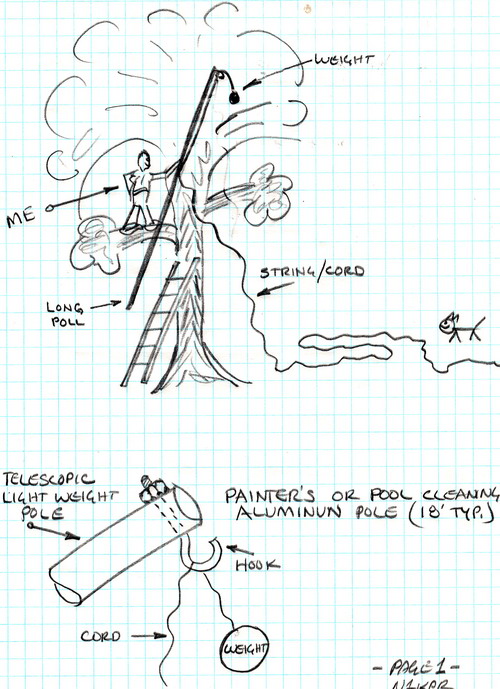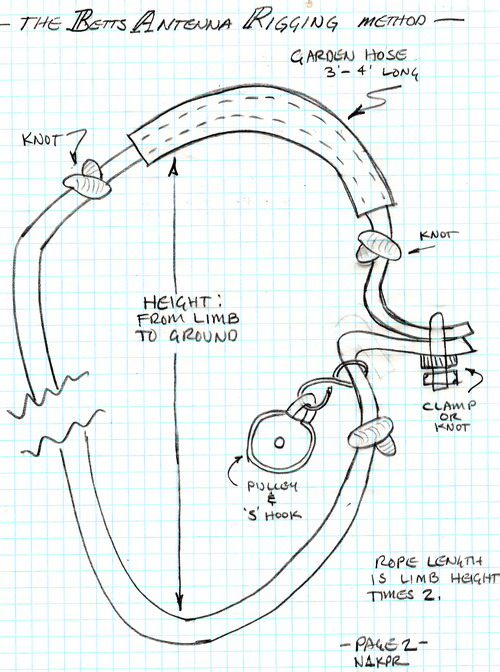
The beauty of this method is that if the halyard or antenna wire breaks - you don't have to climb the tree to rethread the the antenna - just pull the rigging rope and pulley down to you, re-thread it, and pull it back up ... without ever having to climb again! It's also a great time saver if you experiment a lot with various antennas.
Pick out a tree that's a good prospect for the far end of your antenna. Climb only as high as you can "safely." I use a ladder, lashed to the trunk to gain access to the limbs that'll safely hold my mass. I climb as high as I feel comfortable. At that point, I select the limb, high above my head, where the antenna will fasten.
I bring along an 18 foot pool skimming pole which has a hook attached to the end. Over the hook dangles a fishing string with a 1/2 pound weijght.
Once I am secure in my position and footing, I ease the light pole up to the selected limb and "drop" the weight over it while keeping control of the fishing line.
Now, the pole can be dropped (watch out for people and animals) and the line fed out until the weight reaches the ground.
I then carefully decend the tree, ladder, etc.
Once on the ground, I tie my Dacron (polyester) rope (rigging line) to the string and pull it over the limb. Once both ends of the rope are touching the ground, the string and weight are no longer needed.
(Note: I no longer use "Poly" (polypropolene) rope or Nylon rope, due to the environmental degradation properties of those materials.)

I assemble the "rigging line" rope with a pulley (die cast zinc, brass/bronze, or plastic, not steel), and short length of garden hose, as shown.
The hose keeps the rope from becoming a part of the tree, which it will, in 6 to 12 months - believe me.
Also, this is not the place to save money. Buy quality Dacron rope, in a size and strength-rating greater than you'll ever require. I generally use 5/16 diameter rope. And I always use marine grade pulleys which will not rust or corrode.
Now thread the antenna halyard rope through the pulley and pull enough through so that you can still reach the end of it after you've hoisted the pulley with the rigging line. Once this assembly is completed, pull on the "back" side of it so that the pulley rises up to the limb that is supporting it. Be sure the hose is completely over the limb - both ends hanging about equal. Tie it off to the cleat.

Now you can attach the antenna insulator and antenna wire and hoist it up to the pulley. I usually tie on a weight suitably heavy to keep the antenna fairly tight. You may want to do this with a bungee or shock cord to avoid the stress inerta when stiff breezes blow. A paint can with drain holes works well. you can add stones, as required, while you determing the proper weight.
Be sure to leave a generous length of halyard in the event that you want to lower the antenna to repair or change the wire.
As always, use good sense and judgement in climbing. Follow all the safety rules pertaining to overhead wires, potential falling objects, and general safety. Never erect antennas above, below, or near power distribution lines. Do not leave any wire or rope loops large enough for climbing animals to get their heads stuck in.
